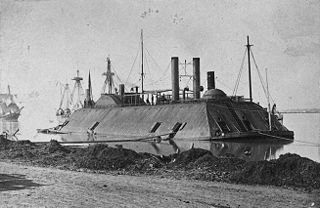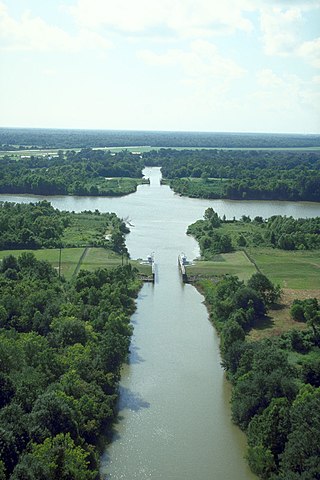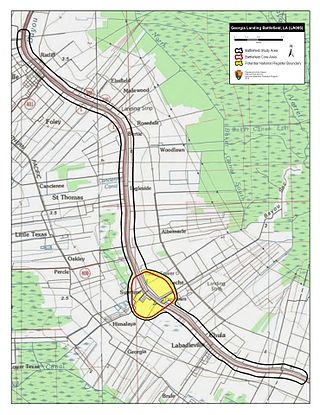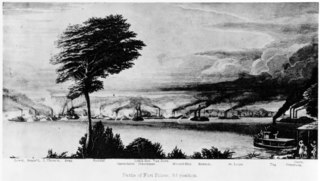
USS Essex was a 1000-ton ironclad river gunboat of the United States Army and later United States Navy during the American Civil War. It was named for Essex County, Massachusetts. USS Essex was originally constructed in 1856 at New Albany, Indiana as a steam-powered ferry named New Era.

Bayou Teche is a 125-mile-long (201 km) waterway in south central Louisiana in the United States. Bayou Teche was the Mississippi River's main course when it developed a delta about 2,800 to 4,500 years ago. Through a natural process known as deltaic switching, the river's deposits of silt and sediment cause the Mississippi to change its course every thousand years or so.

CSS Tennessee was a casemate ironclad ram built for the Confederate Navy during the American Civil War. She served as the flagship of Admiral Franklin Buchanan, commander of the Mobile Squadron, after her commissioning. She was captured in 1864 by the Union Navy during the Battle of Mobile Bay and then participated in the Union's subsequent Siege of Fort Morgan. Tennessee was decommissioned after the war and sold in 1867 for scrap.

USS Carondelet (1861) was a City-class ironclad gunboat constructed for the War Department by James B. Eads during the American Civil War. It was named for the town where it was built, Carondelet, Missouri.

The USS Queen of the West was a sidewheel steamer ram ship and the flagship of the United States Ram Fleet and the Mississippi Marine Brigade. It was built at Cincinnati, Ohio in 1854. It served as a commercial steamer until purchased by Colonel Charles Ellet Jr. in 1862 and converted for use as a ram ship. The ship operated in conjunction with the Mississippi River Squadron during the Union brown-water navy battle against the Confederate River Defense Fleet for control of the Mississippi River and its tributaries during the American Civil War.

Charles Rivers Ellet was a colonel in the Union Army during the American Civil War. He served in the United States Ram Fleet under his father Charles Ellet, Jr. and as commanding officer of the ram fleet as part of the Mississippi Marine Brigade under his uncle Alfred W. Ellet. He commanded the ram ships USS Queen of the West, USS Switzerland, USS Lancaster and USS Monarch during the brown-water navy battle for control of the Mississippi River and its tributaries as part of the Vicksburg Campaign from 1862 to 1863.

USS Varuna was a screw steamer acquired by the Union Navy during the American Civil War. Under construction in 1861, she was purchased incomplete on 31 December. After being commissioned in February 1862, she traveled to join the West Gulf Blockading Squadron. Varuna was present when Flag Officer David Glasgow Farragut led an attack against Confederate positions at Fort Jackson and Fort St. Philip on 24 April. During the action, Varuna ran ahead of the other Union ships, and was engaged in a chase with the Louisiana gunboat Governor Moore. After closing in on the Union ship, Governor Moore rammed Varuna twice, with the gunboat CSS Stonewall Jackson adding a third blow. Varuna sank within 15 minutes, but Farragut was able to capture the city of New Orleans, Louisiana.

Laurent Millaudon was a wooden side-wheel river steamboat launched at Cincinnati, Ohio, in 1856 operating in the New Orleans, Louisiana, area, and captained by W. S. Whann. At the beginning of the American Civil War she was taken into service by the Confederate Navy as CSS General Sterling Price. On 6 June 1862, she was sunk at the Battle of Memphis. She was raised and repaired by the Union army, and on 16 June 1862 was moved into Union service as USS General Price and served until the end of the war.
The second Navy vessel to bear the name Sachem, this screw steamer was built in 1844 at New York City, where it was purchased by the Navy on 20 September 1861.

The Battle of Georgia Landing or Battle of Labadieville was fought between a Union Army force led by Brigadier General Godfrey Weitzel and a Confederate States Army force commanded by Brigadier General Alfred Mouton near Labadieville, Assumption Parish, Louisiana, during the American Civil War. After a sharp clash, the Union troops compelled Mouton's outnumbered force to retreat.

USS Diana was a captured Confederate steamer acquired by the Union Navy from the prize court during the American Civil War. She was put into service by the Union Navy to patrol navigable waterways of the Confederacy to prevent the South from trading with other countries. Unfortunately for the Union Navy, she was again recaptured by the Confederate Navy.

USS Calhoun was a captured Confederate steamer and blockade runner acquired by the Union Navy from the prize court during the American Civil War.

The first USS Barataria was a steamer captured by the Union Army during the American Civil War. She was used by the Union Navy as a gunboat in support of the Union Navy blockade of Confederate waterways.

USS Kinsman, sometimes called USS Colonel Kinsman, was a sidewheel steamer captured by the Union Army during the American Civil War. She was used by the Army and then by the Union Navy as a gunboat in support of the Union Navy blockade of Confederate waterways. On 23 February 1863, she hit a snag and sank.

USS Sumter was a 525-ton sidewheel paddle steamer captured by the Union Navy during the Union blockade of the American Civil War.
CSS Maurepas was a sidewheel steamer that briefly served as a gunboat in the Confederate States Navy during the American Civil War. Built in 1858 in Indiana as Grosse Tete, the vessel was used in commercial trade until 1860 and then delivered mail until 1861, when she was acquired by the Confederate Navy.
CSS Pamlico was a sidewheel steamer that served in the Confederate States Navy during the early stages of the American Civil War. Originally a passenger vessel on Lake Pontchartrain, she was purchased by Confederate authorities on July 10, 1861, and converted into a gunboat. She participated in two minor naval actions in the vicinities of Horn Island and Ship Island in December, before taking part in two more small battles defending the Pass Christian area in March and April 1862. In late April, Union Navy ships passed the defenses of New Orleans, Louisiana. After ferrying Confederate troops out of the city, Pamlico was burned by her crew on Lake Pontchartrain on April 25 to prevent capture.

The 2nd Louisiana Cavalry Regiment was a unit of mounted volunteers recruited in Louisiana that fought in the Confederate States Army during the American Civil War. Breazeale's Cavalry Battalion was formed in July 1862 and was augmented by five additional companies in September 1862 to form a regiment. It served for the entire war west of the Mississippi River in the Trans-Mississippi Department. The regiment fought at Georgia Landing, Fort Bisland, Irish Bend, and Brashear City in 1863 and Henderson's Hill and Mansfield in 1864. Afterward, the regiment fought in minor skirmishes before the Trans-Mississippi's final surrender on 26 May 1865.

The 1st Louisiana Field Battery was an artillery unit recruited from volunteers in Louisiana that fought in the Confederate States Army during the American Civil War. The battery mustered into Confederate service in October 1861. The unit traveled to Fort Jackson in early 1862 and took part in the defense of Forts Jackson and St. Philip. The soldiers became prisoners when the forts surrendered and the battery reformed at Franklin after their prisoner exchange. The battery fought at Fort Bisland and Irish Bend in 1863. Later in the year the battery engaged Union shipping on the rivers in several actions. In 1864 the battery briefly fought at Mansfield before its commander was killed while engaging Union gunboats on the Red River. The unit also fought at Mansura and Yellow Bayou. The battery was in Texas when the Trans-Mississippi Department surrendered in May 1865.
















